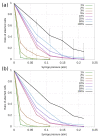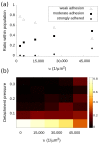Dissociation Constant of Integrin-RGD Binding in Live Cells from Automated Micropipette and Label-Free Optical Data
- PMID: 33498959
- PMCID: PMC7911545
- DOI: 10.3390/bios11020032
Dissociation Constant of Integrin-RGD Binding in Live Cells from Automated Micropipette and Label-Free Optical Data
Abstract
The binding of integrin proteins to peptide sequences such as arginine-glycine-aspartic acid (RGD) is a crucial step in the adhesion process of mammalian cells. While these bonds can be examined between purified proteins and their ligands, live-cell assays are better suited to gain biologically relevant information. Here we apply a computer-controlled micropipette (CCMP) to measure the dissociation constant (Kd) of integrin-RGD-binding. Surface coatings with varying RGD densities were prepared, and the detachment of single cells from these surfaces was measured by applying a local flow inducing hydrodynamic lifting force on the targeted cells in discrete steps. The average behavior of the populations was then fit according to the chemical law of mass action. To verify the resulting value of Kd2d = (4503 ± 1673) 1/µm2, a resonant waveguide grating based biosensor was used, characterizing and fitting the adhesion kinetics of the cell populations. Both methods yielded a Kd within the same range. Furthermore, an analysis of subpopulations was presented, confirming the ability of CCMP to characterize cell adhesion both on single cell and whole population levels. The introduced methodologies offer convenient and automated routes to quantify the adhesivity of living cells before their further processing.
Keywords: adhesion; biosensor; integrin-RGD-binding; micropipette; two-dimensional dissociation constant; waveguide.
Conflict of interest statement
Balint Szabo is the founder of the CellSorter Biotechnology Innovations Company.
Figures




Similar articles
-
Glycocalyx regulates the strength and kinetics of cancer cell adhesion revealed by biophysical models based on high resolution label-free optical data.Sci Rep. 2020 Dec 30;10(1):22422. doi: 10.1038/s41598-020-80033-6. Sci Rep. 2020. PMID: 33380731 Free PMC article.
-
Dependence of cancer cell adhesion kinetics on integrin ligand surface density measured by a high-throughput label-free resonant waveguide grating biosensor.Sci Rep. 2014 Feb 7;4:4034. doi: 10.1038/srep04034. Sci Rep. 2014. PMID: 24503534 Free PMC article.
-
Integrin targeting of glyphosate and its cell adhesion modulation effects on osteoblastic MC3T3-E1 cells revealed by label-free optical biosensing.Sci Rep. 2018 Nov 27;8(1):17401. doi: 10.1038/s41598-018-36081-0. Sci Rep. 2018. PMID: 30479368 Free PMC article.
-
Integrins in drug targeting-RGD templates in toxins.Curr Pharm Des. 2006;12(22):2749-69. doi: 10.2174/138161206777947713. Curr Pharm Des. 2006. PMID: 16918409 Review.
-
Therapeutic effect of arginine-glycine-aspartic acid peptides in acute renal injury.Clin Exp Pharmacol Physiol. 1998 Mar-Apr;25(3-4):276-9. doi: 10.1111/j.1440-1681.1998.t01-2-.x. Clin Exp Pharmacol Physiol. 1998. PMID: 9590583 Review.
Cited by
-
Global Protein-Ligand Binding Affinity Profiling via Photocatalytic Labeling.bioRxiv [Preprint]. 2025 Jul 6:2025.07.04.662444. doi: 10.1101/2025.07.04.662444. bioRxiv. 2025. PMID: 40631297 Free PMC article. Preprint.
-
Simple and automatic monitoring of cancer cell invasion into an epithelial monolayer using label-free holographic microscopy.Sci Rep. 2022 Jun 16;12(1):10111. doi: 10.1038/s41598-022-14034-y. Sci Rep. 2022. PMID: 35710696 Free PMC article.
-
Single-cell adhesion strength and contact density drops in the M phase of cancer cells.Sci Rep. 2021 Sep 16;11(1):18500. doi: 10.1038/s41598-021-97734-1. Sci Rep. 2021. PMID: 34531409 Free PMC article.
References
-
- Beckerle M.C. Cell Adhesion. Oxford University Press Inc.; New York, NY, USA: 2001.
-
- Slack J.M.W. Principles of Tissue Engineering. 4th ed. Elsevier; Amsterdam, The Netherlands: 2013. Molecular Biology of the Cell. - DOI
MeSH terms
Substances
Grants and funding
LinkOut - more resources
Full Text Sources
Other Literature Sources

